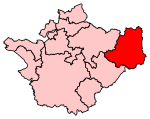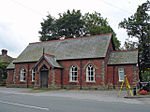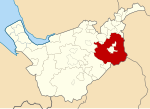Mill House, Adlington
1603 establishments in EnglandCheshire building and structure stubsCountry houses in CheshireGrade II* listed buildings in CheshireGrade II* listed houses ... and 3 more
Houses completed in 1603Timber framed buildings in CheshireUnited Kingdom listed building stubs
Mill House is a former country house in the parish of Adlington, Cheshire, England. It is dated 1603, and was built by Sir Uriah Legh, of the Legh family of Adlington, as a dower house. Alterations were made to it in the middle of the 18th century and in the early 20th century. It is a timber-framed building with some plastered brick infill; it has a Kerridge stone-slate roof. The house is recorded in the National Heritage List for England as a designated Grade II* listed building.
Excerpt from the Wikipedia article Mill House, Adlington (License: CC BY-SA 3.0, Authors).Mill House, Adlington
London Road,
Geographical coordinates (GPS) Address Nearby Places Show on map
Geographical coordinates (GPS)
| Latitude | Longitude |
|---|---|
| N 53.3079 ° | E -2.14073 ° |
Address
London Road
London Road
SK10 4DU , Adlington
England, United Kingdom
Open on Google Maps








